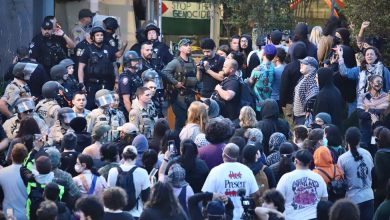Amelia Earhart’s Helmet Sells for $825,000

Good morning. It’s Wednesday. Today we’ll follow up on two tantalizing stories you might have read, but now there are new details you’ll want to know about. One story was about the leather helmet that Amelia Earhart wore when she flew across the Atlantic. The other story was about a former Harlem drug kingpin who became an informant and was killed last fall.

Credit…Shelby Tauber for The New York Times
Amelia Earhart’s long-lost leather helmet was sold to a mystery buyer for $825,000, more than 10 times the presale estimate. Heritage Auctions, which conducted the sale over the weekend, would not say who purchased it.
The writer Laurie Gwen Shapiro explained how Earhart apparently lost it when a crowd swarmed around her in Cleveland in 1929, a year after her first trans-Atlantic flight. She had flown to Cleveland for the grueling eight-day Women’s National Air Derby, a race that became known as the “Powder Puff Derby.”
It was the same race at which Earhart’s goggles went missing. They eventually turned up, minus the lenses, and were donated to the Smithsonian Institution in 1957.
The auction raised the question: Who could spend that much money on a worn leather helmet? And who is so passionate about flight that he or she would want to?
One possibility is Jeff Bezos, who took a pair of Earhart’s goggles on his brief ride into space last summer. Safely back on Earth, Bezos held up those goggles — not the pair from the Smithsonian, according to a Smithsonian spokesman — and said, “Thank you, Amelia, wherever you are — we hope you’re watching all of this.”
An email to Blue Origin, Bezos’s space company, went unanswered. Chris Ivy, the head of sports auctions at Heritage, would not say whether Bezos had been the winning bidder. Nor would he say that Bezos was not the buyer.
The helmet was consigned by Anthony Twiggs, a photographer who inherited it from his mother more than 20 years ago. On the few occasions when she talked about it, she said she had been in the crowd when Earhart touched down. She said a boy who had a crush on her gave her the helmet, saying he had found it on the ground.
“There was no proof,” Shapiro told me. “How do you prove provenance when you just have a good story? His mother fudged her age. That’s why they were a little nervous. Was Mom making up the story?”
Twiggs turned to photo matching, a relatively new digital method of comparing items against old photos. The helmet matched a famous photograph of Earhart taken in Boston before her trans-Atlantic flight.
“The thing about Amelia Earhart was she was crafted almost like a reality show,” Shapiro said. “She had the perfect look, all-American. They posed her like Lindbergh, and people called her Lady Lindy.”
She was not even at the controls on the trans-Atlantic flight. The pilot and the navigator were men, Shapiro said.
When they returned, they were treated to a ticker-tape parade. “Nobody really cared about the pilots,” Shapiro said. “From that moment, she was an overnight celebrity. The same thing had happened to Lindy. The aviators really were the gods of the 20s.”
Road rage in an informant’s killing
Albert (Alpo) Martinez was a notorious Harlem drug kingpin who became an informant. He lived in Maine under the federal witness protection program, but he could not resist going back to Harlem from time to time. He was shot to death there in October.
It turns out the gunman was not someone on his long list of enemies, but someone angry about his road manners — or lack of them. The police have charged Shakeem Parker, 27, in Martinez’s murder, a senior law enforcement official said.
Martinez, on a motorcycle, had brushed past Parker several months earlier. Parker interpreted it as disrespectful. They traded words but parted ways.
Martinez was back in Harlem in October. Parker noticed Martinez’s pickup on the street, walked over to the driver’s side window and opened fire, the police official said. Martinez sped off, mortally wounded. He crashed into a parked car several blocks away, leaving a trail of heroin packets in his wake. Law enforcement officials speculate that he tossed them out of the truck, worried that police would arrest him when they arrived.
Weather
It’s a mostly sunny day with temps in the 40s, but expect a chance of showers late at night.
alternate-side parking
Suspended today (Ash Wednesday).
The latest New York news
-
New York City will end its main coronavirus contact-tracing program next month, yet another sign that officials are shifting the way they address the Covid-19 threat.
-
A 61-year-old woman who was assaulted in Queens in November died from her injuries last week, the latest death in a series of attacks against New Yorkers of Asian descent.
The research that goes into fiction
Years ago, I wrote a story about a law student named Brad Meltzer. I heard about him from someone who told me a law student at Columbia had signed a multibook deal — to write novels, not legal textbooks.
I tracked him down. I wrote the story. His first novel came out. He has written a dozen more since then. His latest, “The Lightning Rod,” will be published next week. I thought it was time to catch up.
Since then, he has had big sellers in the fiction, nonfiction, advice and children’s categories. He read aloud to an audience of one — former President George H.W. Bush, not long before Bush died in 2018. He helped find the flag that firefighters raised in the ruins of the World Trade Center on Sept. 11, 2001. He was involved with several television shows. He became a hero to Superman fans for raising money to repair the childhood home of one of Superman’s creators. (It is in Cleveland, not on Krypton.) He became a parent.
What has struck me over the years is how much his books are built on research — on information he discovered and used to tell a story. I remember thinking this when his first novel, “The Tenth Justice,” was published a year after the article I wrote. The main character was a law clerk. I figured Meltzer knew some law clerks and could marry details about their work lives to a plot that had also required research.
Several books later, he created another character when someone told him the Army had an artist in residence who went where the troops did. That character, who first appeared in “The Escape Artist,” returns in “The Lightning Rod.”
“I’m just reporting my life,” he told me last month. “My son is 20, picked up ‘The Lightning Rod,’ first person reading the actual copy that I know. It’s a terrifying moment for me. I can withstand what everyone else says, but it’s my own child.”
With a sigh of relief, he added: “He reads the first chapter and immediately comes back to me, ‘Great opening.’”
“OK, I made it past Chapter 1,” Meltzer said. “But then he says to me, ‘I can’t believe how many things in this book are winks and nods to us.’ He didn’t say ‘winks and nods.’ He said, ‘I can’t believe how many things in this book are about us.’ He was reading through it and going, ‘This is our life.’ I didn’t even think about it.”
We also talked about how his world and my world are much more audience-conscious than they were in 1997, when his first book came out. “When we were doing one of the books, a couple of books ago, the head of marketing at our publisher, at Hachette, said, ‘Everything we do for all our other authors, it doesn’t work on your audience.’ I said, ‘Why?’ They said, ‘Your audience wants something different.’ It was the first time I had thought, ‘Our audience.’ I never thought there was a certain type of person who was somehow following this.”
What we’re reading
-
In the “Little Odessa” and “Ukrainian Village” neighborhoods, the city’s Ukrainian population finds comfort and community, The Wall Street Journal reports.
-
Some New York City schools are struggling to spend federal pandemic aid before the end of the school year, Chalkbeat reports.
MetROPOLITAN diary
Across Eighth Avenue
Dear Diary:
I was waiting to cross Eighth Avenue at 23rd Street when an older woman asked me if I would help her cross the street.
I offered her my arm, and we chatted as we walked the two blocks to her apartment. At one point, we passed an older man who was using a walker.
The woman whispered to me that he lived in her building and was not very nice.
After dropping her at the entrance to her building, I walked past the man with the walker. He motioned for me to stop.
“That was so nice of you to help her,” he said. “Nobody in our building likes her. She’s really mean.”
— Paul Breen
Illustrated by Agnes Lee. Send submissions here and read more Metropolitan Diary here.
Glad we could get together here. See you tomorrow. — J.B.
P.S. Here’s today’s Mini Crossword and Spelling Bee. You can find all our puzzles here.
Melissa Guerrero, Reagan Lopez, Olivia Parker and Ed Shanahan contributed to New York Today. You can reach the team at [email protected].
.



